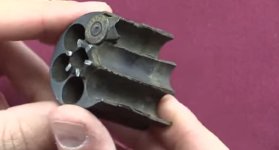HighValleyRanch
New member
Here is a review on Underwood's .357 magnum 158 grain gold dot jhp ammo. It is a perfect example of what I was trying to demonstrate in this thread.
https://youtu.be/gO9CNI8qV2I
While Underwood states on their box that this load gives 1500 fps, in the actual real life testing (at least in this one example) the shooter from his 4" barrel revolver only got 1142 fps for a ME of 458 ft. lbs with 158 grains.
In my own testing of Buffalobore;s .38 special +P out of my 4" Ruger Security six I got 1177 fps with the 158 grain bullet. You can see that it is a little higher than the Underwood .357 magnum.
So with my choice of .38 special +P loads I was able to match what many considered Underwood's "full house" .357 magnum loads to be.
https://youtu.be/gO9CNI8qV2I
While Underwood states on their box that this load gives 1500 fps, in the actual real life testing (at least in this one example) the shooter from his 4" barrel revolver only got 1142 fps for a ME of 458 ft. lbs with 158 grains.
In my own testing of Buffalobore;s .38 special +P out of my 4" Ruger Security six I got 1177 fps with the 158 grain bullet. You can see that it is a little higher than the Underwood .357 magnum.
So with my choice of .38 special +P loads I was able to match what many considered Underwood's "full house" .357 magnum loads to be.
Last edited:


